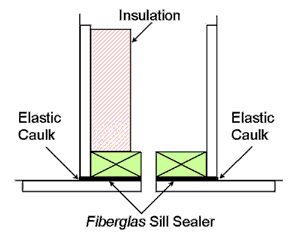Sound and Noise Control – Stop Air – Denser is Better
DEAR TIM: My brother lives in a condominium complex. His unit is virtually soundproof. Rarely can you hear any exterior noise or sounds from other units. My current home is not soundproof. Can I do anything to lower sound transmission in my home? What could have been done during construction to make my house more soundproof? N.L.
DEAR N. L.: Excuse me, did you say something? I couldn't hear you. Just kidding! Soundproofing is an often misunderstood and neglected aspect of residential construction. I'm glad you asked the question. Perhaps it's best to start by understanding sound.
How is Noise or Sound Created?

Sound is created when something vibrates. Think about hitting a tuning fork against a hard surface. How about a rock-and-roll drummer hitting a cymbal or any of the drums?
These vibrations create sound waves that travel through the air. The sound waves then can either bounce off objects and/or cause them to begin vibrating.
What is Sympathetic Sound?
This additional vibration then creates sound waves on the other side of the object. This is how our ears work. Sound waves produced by a vibrating object travel through the air into our inner ear. These waves cause our eardrum to vibrate. Our brains then compute whether the vibrations are noise (unwanted sound) or pleasurable sounds such as conversation or music. I fully realize that some conversation and music can be noise depending on who's vocal cords are vibrating.
One way to minimize sympathetic sound is to make sure a wall assembly is not balanced. This is one reason a soundproof radio studio has window glass panes that are not parallel.
You can also add a 5/8-inch thick layer of drywall to one side of a wall that already has 1/2-inch drywall on both sides. If new construction, consider putting 1/2-inch drywall on one side of a wall and 5/8-inch on the other side to prevent sympathetic resonant vibration.
Dense or Thick Things Need More Energy
When sound is produced it has a certain amount of energy. The amount of energy is in direct proportion to the volume of the sound. So the louder a sound the greater its ability to vibrate objects such as walls, floors, and ceilings. If an object is lightweight or has a small density, it doesn't take much energy to get it to vibrate. Heavy, dense items require much greater amounts of energy to get them to vibrate. This is why older homes are more soundproof than newer homes. They tend to have thicker walls, ceilings, and floors.
What About Blocking Air?
Unfortunately, since your home is already built, the only sound that you can control is that sound which is still airborne. You need to block all pathways of air that are leaking air into the room.
Think of the room as an aquarium and begin plugging these leaks. For example, caulk all cracks in the room, especially where walls contact floors. Caulk holes inside of electrical boxes and around the edges of these boxes where they contact the drywall, plaster, or paneling. Install tight weatherstripping around doors and windows.
Soundproofing New Construction
If you are getting ready to build, you have many opportunities to soundproof. Remember, we need to stop airborne sound waves and those sound waves which travel by vibration through the structure.
Airborne sound waves can be stopped by using wall and floor materials that tend to absorb sound rather than reflect it. You can also have your builder caulk underneath all wall plates so that sound can't travel under a wall. Make sure that electrical outlet boxes from two back to back rooms are not in the same stud cavity. Install fiberglass sound batts in walls to block airborne sound waves that get into a wall cavity. Consider using insulated ductwork for your heating and cooling system.
Isolated Things That Vibrate
Vibrations caused by things in the house must be isolated. Do not allow plumbing pipes to touch framing members. Isolate them with pieces of rubber or caulk where they pass through floor joists and wall plates. Isolate any vibrating thing (furnaces, washing machines, dryers, fans, etc.) from direct contact with framing members. Without isolation, the vibrations will eventually create airborne sound waves which you will then hear.
Separate Wall Studs
Construct critical wall assemblies using two rows of studs which do not touch one another. The wall finish material for each room is applied on a separate row of studs. This stops the vibrations from one room from vibrating the drywall on the other side. If you can't afford two rows of studs, consider applying a metal resilient furring strip horizontally across the studs on each side of the wall. Then attach the drywall (two layers, if possible) to these strips. Apply 6 mil plastic to the studs before you apply the furring strips to the studs. This helps to isolate vibrations between the two objects.
Remember, stop the vibrations and you will stop the noise.
2 Responses to Sound and Noise Control – Stop Air – Denser is Better